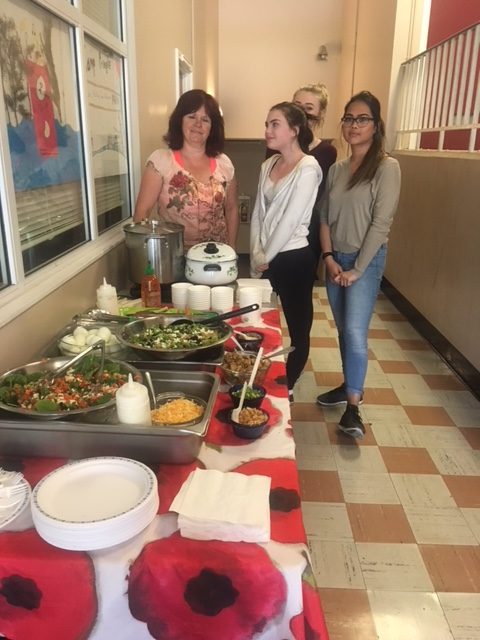Rockheights Middle School, Victoria, BC
2017-2018 (Year 2)
A bit about our school and location…
We acknowledge that we are located on the unceded territory of the Songhees and Esquimalt First Nations. Our small school is located in Esquimalt, a small municipality in Victoria, British Columbia. It is situated in a quiet residential neighbourhood and is surrounded by beautiful trees and Garry Oak meadows. Our neighbourhood is home to the CFB Esquimalt Military Base and many of our students come from military families.
What we’ve done so far
We were fortunate to receive the Farm to School grant in 2016, and have been working towards our vision of A school food culture where healthy, local eating, food literacy education and traditional food and plant knowledge is a part of the daily lives.
During the 2016/2017 school year, there were a few key champions who helped realize this vision. A superstar Educational Assistant Deb Clarke was the mastermind behind our amazing salad bars and soup club, while a passionate and dedicated teacher, Beth Mann, took on the creation of a small garden behind our school! Each week students were so excited when soup or salad was served… and people would run to line up when they heard the bell!
In 2017/2018 we came up against a few hurdles and while we did not have as many soup days or salad bars during that school year, the vision itself was alive and well with many individual teachers incorporating food literacy education, gardening and traditional plant knowledge into their classrooms and curriculum. Some teachers were growing seedlings in their classroom, creating hypotheses and studying their science curriculum through the growing of food in their rooms. Other teachers went on field trips and learned about local native plants. One teacher had food as the underlying theme for all subjects for one term. The students created a “garbage garden” on the back porch of the classroom. Each student created a planter out of a found object that would have otherwise become garbage (like a popped basketball, an old boot, a chipped bowl etc). They researched which food plants would grow well under the conditions available and they started seedlings inside, which they transplanted to the “garbage garden”. Some students went on a camping trip to Galiano Island where they participated in a workshop called “Future of Food”. They learned about food forests, beekeeping and had many hands-on experiences.
Now and into the future…
So far this year we have had huge progress on our school garden. One of our fabulous EAs is based in a room next to the garden, and works with students one on one and in small groups. They have had great success getting the beds planted with a variety of winter vegetables, and will be using some of them in the upcoming “seasonal lunches” that we will be providing to schools this year. We have partnered with the nearby high school to have 4 new beds created for our garden. We are now getting soil for them and more classes will be joining to do more planting. Working with the Esquimalt Farmers market, we have made contact with many local farms and food providers. We will be creating seasonal lunches of soup and salad bars throughout the school year, using a combination of food that we are growing in our garden as well as food from nearby farms.
Rockheights Middle School
1250 Highrock Ave,
Victoria, BC
V9A 4V7
Student enrollment – 204
2016-2017 (Year 1)
Sow Much Salads: Getting our Green on at Rockheights!
 Rockheights Middle School, located in the Township of Esquimalt is a school with 215 students, 56% of whom are considered at risk in the vulnerability index. For our specific garden project, a class of 25 grade six students and five grade 8 students are directly involved. Our grade 8 students are volunteering their time and expertise, while learning along the way.
Rockheights Middle School, located in the Township of Esquimalt is a school with 215 students, 56% of whom are considered at risk in the vulnerability index. For our specific garden project, a class of 25 grade six students and five grade 8 students are directly involved. Our grade 8 students are volunteering their time and expertise, while learning along the way.
The Farm to School program has helped us to connect with members of our community including but not limited to Aboriginal Elders, Esquimalt Parks and Recreation municipal workers (Parks division), staff in the School District Grounds Department and the FoodSafe Program.
Students began the season learning about what plants need to be successful including learning about the seasons and the amount of sunlight that occurs during different times of the year. They also learned how the sunshine impacts growth. An example of the way that this was incorporated was that students made sundials out of recycled materials and used them to track how much sunlight was present at various times in the school year.
For approximately one month at the beginning of the project, our Aboriginal Skills Development teacher, worked with the students to teach them about the native plants that are growing in our local community. Students learned about medical and traditional uses for many plants including the Camus, the Thistle, and the Oregon Grape.
Students conducted self-guided experiments on plant growth which included; soil type (organic vs. non organic), amount of water, location, sunlight and seed depth. They used the information they learned to plant their own garden using the best techniques as found in the self-guided experiments.
In the fall, our School District put up a fence to provide a safe space for the cold frame garden beds. We bought additional gardening implements and gloves on the fall sale racks, so our gardening shed is growing too.
Our in school connection has been our grade 8 volunteers working to help plan and prepare the salad bar. helped the older students to understand what the younger students needed. The second bed was built by a volunteer community member who has a connection a connection to Rockheights. Due to these delays, our garden didn’t get planted until later in the year than originally hoped. It was planted in early April. Since planting, students have checked on the garden daily and were assigned tasks in order to monitor the plants. Some of the tasks included: fertilizing, watering, thinning, weeding and opening the cold frame bed.
The focus of our garden again this year has been a “salad garden.” The plants include: lettuce, radishes, mixed greens, mustard greens, spinach, peas, beans and green onions. We have also started experimenting with herbs with the hope of supplying herbs to a local restaurant. These plants are quick growing plants and the students will be able to enjoy them in a salad in approximately 6-8 weeks from planting. As a part of the Farm to School grant, our home economics teacher and one of our Educational Assistants have been integral with setting up a salad bar 8 times this year. On Wednesdays, we offer home made soup and a salad bar. At Rockheights Middle School we have turned the mid-week sprawl into the mid-week burst because of the fabulous plates of salad that are being anticipated by students and the nutrition it affords for productive afternoons following lunch. Our soups are infused with herbs from the garden.
On a field trip, the class of students participated in our local township “Earth Day clean-up” of invasive species, as we do every year. It helped students to make the connection between local, native plants and our community.
Next year, we have a grade 7 teacher who has committed to coming on board with his class. They will build two more beds and begin in the fall, growing the program and having more students involved both through educational programs and we will continue with our Soup Club/Salad Bar students. Eventually, we will create a seating area in the larger garden bed area in order to take the classroom outside, especially during the independent reading time in our day. Our goal is to continue this project from the beginning of the school year and we feel that we will be able to do so, now that our garden beds are complete. This will allow for several harvests throughout the year.




